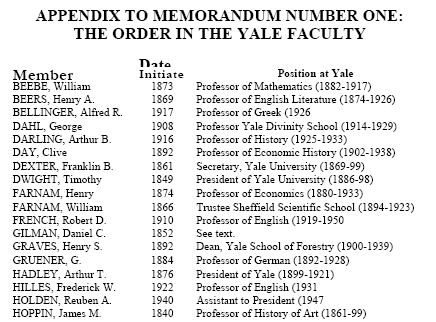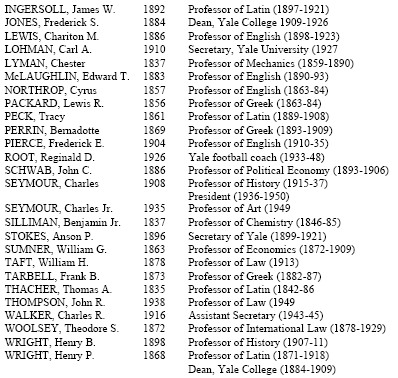|
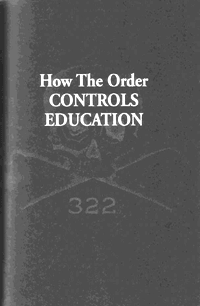
Memorandum Number One:
It All Began At Yale
The first volume of this series introduced The Order, presented
three preliminary hypotheses with examples of the evidence to come.
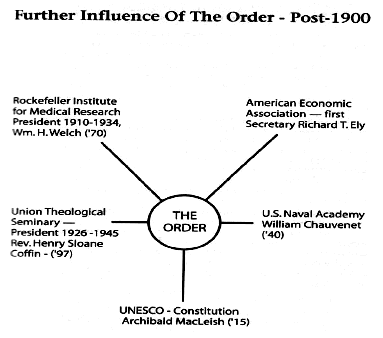
We also asserted that any group that wanted to control the future of
American society had first to control education, i.e., the
population of the future. This volume will outline the way in which
education has been controlled by The Order.
It all began at Yale. Even the official Yale history is aware of
Yale's power and success:
"The power of the place remain(s)
unmistakable. Yale was organized. Yale inspired a loyalty in its
sons that was conspicuous and impressive. Yale men in after life
made such records that the suspicion was that even there they were
working for each other. In short, Yale was exasperatingly and
mysteriously successful. To rival institutions and to academic
reformers there was something irritating and disquieting about old
Yale College."1
"Yale was exasperatingly and mysteriously successful," says the
official history.
1 George Wilson Pierson, YALE COLLEGE 1871-1922 (Yale University
Press. New Haven. 1952) . volume One, p. 5.
And this success was more than obvious to Yale's chief competitor,
Harvard University. So obvious, in fact, that in 1892 a young
Harvard instructor, George Santanyana, went to Yale to investigate
this "disturbing legend" of Yale power. Santanyana quoted a Harvard
alumnus who intended to send his son to Yale - because in real life
"all the Harvard men are working for Yale men." 2
2 E.E. Slosson, GREAT
AMERICAN UNIVERSITIES (New York, 1910) pp. 59-60.
But no one has previously asked an obvious question - Why? What is
this "Yale power"?
A Revolutionary Yale Trio
In the 1850s, three members of The Order left Yale and working
together, at times with other members along the way, made a
revolution that changed the face, direction and purpose of American
education. It was a rapid, quiet revolution, and eminently
successful. The American people even today, in 1983, are not aware
of a coup d'etat.
The revolutionary trio were:
-
Timothy Dwight ('49) Professor in the Yale Divinity School and then
12th President of Yale University.
-
Daniel Coit Gilman ('52), first President of the University of
California, first President of the Johns Hopkins University and
first President of the Carnegie Institution.
-
Andrew Dickson White ('53), first President of Cornell University
and first President of the American Historical Association.
This notable trio were all initiated into
The Order within a few
years of each other (1849, 1852, 1853). They immediately set off for
Europe. All three went to study philosophy at the University of
Berlin, where post-Hegelian philosophy had a monopoly.
-
Dwight studied at the Universities
of Berlin and Bonn between 1856 and 1858
-
Gilman was at the University of Berlin between 1854 and 55 under
Karl von Ritter and Friedrich Trendelenberg, both prominent "Right"
Hegelians
-
White studied at the University of Berlin between 1856 and 1858.
Notably also at the University of Berlin in 1856 (at the
Institute
of Physiology) was none other than Wilhelm Wundt, the founder of
experimental psychology in Germany and the later source of the
dozens of American PhDs who came back from Leipzig, Germany to start
the modern American education movement.
Why is the German experience so important?
Because these were the
formative years, the immediate post graduate years for these three
men, the years when they were planning the future, and at this
period Germany was dominated by the Hegelian philosophical ferment.
There were two groups of these Hegelians. The right Hegelians, were
the roots of Prussian militarism and the spring for the unification
of Germany and the rise of Hitler. Key names among right Hegelians
were Karl Ritter (at the University of Berlin where our trio
studied), Baron von Bismarck, and Baron von Stockmar, confidential
adviser to Queen Victoria over in England. Somewhat before this,
Karl Theodor Dalberg (1744-1817), arch-chancellor in the German
Reich, related to Lord Acton in England and an Illuminati (Baco v
Verulam in the Illuminati code), was a right Hegelian.
There were also Left Hegelians, the promoters of scientific
socialism. Most famous of these, of course, are Karl Marx, Friedrich
Engels, Heinrich Heine, Max Stirner and Moses Hess.
The point to hold in mind is that both groups use Hegelian theory of
the State as a start point, i.e., the State is superior to the
individual. Prussian militarism, Nazism and Marxism have the same
philosophic roots.
And it left its mark on our trio.
Daniel Coit Gilman
Gilman wrote his sister in 1854 that what he most desired to do on
returning home to America was to "influence New England minds." An
extract from one Gilman letter is worth quoting at length.
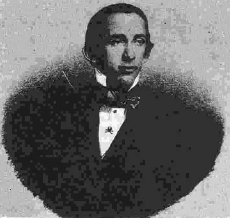 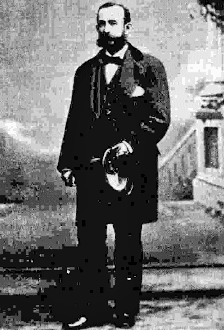
Daniel C. Gilman in the early seventies as president of the
University of California
Gilman wrote his sister from St. Petersburg in April, 1854:
And what do you think I am "keeping" for? Tell me, some day when you
write, for every year makes me feel that I must draw nearer to a
point. When I go home to America I must have some definite notions.
Day and night I think of that time, and in all I see and do I am
planning for being useful at home. I find my wishes cling more and
more towards a home in New England, and I long for an opportunity to
influence New England minds.
If I am an editor, New York is the
place; but, to tell the truth, I am a little afraid of its
excitements, its politics, its money-making whirl. I look therefore
more and more to the ministry as probably the place where I can do
more good than anywhere else; that is to say, if I can have a
congregation which will let me preach such things as we have talked
over so many times in our up-stairs confabs.
I am glad you remember
those talks with pleasure, for I look upon them as among the
greatest "providences" of my life. If ever I make anything in this
world or another I shall owe it to the blessed influences of home.
For me, it seems as though new notions and wider views of men and
things were crowding upon me with wonderful rapidity, and every day
and almost every hour I think of some new things which I wish to
have accomplished in America....
I find my thoughts, unconsciously,
almost, dwelling on the applications of Christianity or the
principles of the New Testament to business, study, public
education, political questions, travel, and so forth. I had a long
talk with Mr. Porter in Berlin (it was three days long with
occasional interruptions) on topics related to such as I have named,
and he assures me that there are many places in New England ripe for
the advocacy of some such views upon these questions as I have often
hinted to you at home.
I told him a great deal about my thoughts on
such things, talking quite as freely and perhaps more fully than I
have ever done with you girls at home: He seemed exceedingly
interested .... He told me that the kind of preaching I spoke of was
the kind now needed - the kind which would be most influential of
good - and on the whole he encouraged me to attempt it. I feel more
and more desirous to do so, and shall keep on, in all I see and hear
abroad, with the examination of every influence now working upon men
- churches and schools, politics and literature ...1
1 Fabian Franklin, THE LIFE OF DANIEL COIT GILMAN (Dodd, Mead. New
York, 1910), pp. 28-9.
Daniel Coit
Gilman is the key activist in the revolution of education by The
Order. The Gilman
family came to the United States from Norfolk, England in 1638. On
his mother's side, the Coit family came from Wales to Salem,
Massachusetts before 1638.
Gilman was born in Norwich, Connecticut July 8, 1831, from a family
laced with members of The Order and links to Yale College (as it was
known at that time).
Uncle Henry Coit Kingsley (The Order '34) was Treasurer of Yale from
1862 to 1886. James I. Kingsley was Gilman's uncle and a Professor
at Yale. William M. Kingsley, a cousin, was editor of the
influential journal New Englander.
On the Coit side of the family, Joshua Coit was a member of The
Order in 1853 as well as William Coit in 1887. Gilman's
brother-in-law, the Reverend Joseph Parrish Thompson ('38) was in
The Order. Gilman returned from Europe in late 1855 and spent the
next 14 years in New Haven, Connecticut - almost entirely in and
around Yale, consolidating the power of The Order.
His first task in 1856 was to incorporate Skull & Bones as a legal
entity under the name of The Russell Trust. Gilman became Treasurer
and William H. Russell, the cofounder, was President. It is notable
that there is no mention of The Order, Skull & Bones, The Russell
Trust, or any secret society activity in Gilman's biography, nor in
open records.
The Order, so far as its members are concerned, is
designed to be secret, and apart from one or two inconsequential
slips, meaningless unless one has the whole picture. The Order has
been remarkably adept at keeping its secret. In other words, The
Order fulfills our first requirement for a conspiracy - i.e., IT IS
SECRET.
The information on The Order that we are using surfaced by accident.
In a way similar to the surfacing of the Illuminati papers in 1783,
when a messenger carrying Illuminati papers was killed and the
Bavarian police found the documents. All that exists publicly for
The Order is the charter of the Russell Trust, and that tells you
nothing.
On the public record then, Gilman became assistant Librarian at Yale
in the fall of 1856 and "in October he was chosen to fill a vacancy
on the New Haven Board of Education." In 1858 he was appointed
Librarian at Yale. Then he moved to bigger tasks.
The Sheffield Scientific School
The Sheffield Scientific School, the science departments at Yale,
exemplifies the way in which The Order came to control Yale and then
the United States.
In the early 1850s, Yale science was insignificant, just two or
three very small departments. In 1861 these were concentrated into
the Sheffield Scientific School with private funds from Joseph E.
Sheffield. Gilman went to work to raise more funds for expansion.
Gilman's brother had married the daughter of Chemistry Professor
Benjamin Silliman (The Order, 1837). This brought Gilman into
contact with Professor Dana, also a member of the Silliman family,
and this group decided that Gilman should write a report on
reorganization of Sheffield. This was done and entitled "Proposed
Plan for the Complete Reorganization of the School of Science
Connected with Yale College."
While this plan was worked out, friends and members of The Order
made moves in Washington, D.C., and the Connecticut State
Legislature to get state funding for the Sheffield Scientific
School. The Morrill Land Bill was introduced into Congress in 1857,
passed in 1859, but vetoed by President Buchanan. It was later
signed by President Lincoln.
This bill, now known as the Land Grant
College Act, donated public lands for State colleges of agriculture
and sciences .... and of course Gilman's report on just such a
college was ready. The legal procedure was for the Federal
government to issue land scrip in proportion to a state's
representation, but state legislatures first had to pass legislation
accepting the scrip.
Not only was Daniel Gilman first on the scene
to get Federal land scrip, he was first among all the states and
grabbed all of Connecticut's share for Sheffield Scientific School!
Gilman had, of course, tailored his report to fit the amount
forthcoming for Connecticut. No other institution in Connecticut
received even a whisper until 1893, when Storrs Agricultural College
received a land grant.
Of course it helped that a member of The Order, Augustus Brandegee
('49), was speaker of the Connecticut State Legislature in 1861 when
the state bill was moving through, accepting Connecticut's share for
Sheffield. Other members of The Order, like Stephen W. Kellogg ('46)
and William Russell ('33), were either in the State Legislature or
had influence from past service.
The Order repeated the same grab for public funds in New York State.
All of New York's share of the Land Grant College Act went to
Cornell University. Andrew Dickson White, a member of our trio, was
the key activist in New York and later became first President of
Cornell. Daniel Gilman was rewarded by Yale and became Professor of
Physical Geography at Sheffield in 1863.
In brief, The Order was able to corner the total state shares for
Connecticut and New York, cutting out other scholastic institutions.
This is the first example of scores we shall present in this series
- how The Order uses public funds for its own objectives.
And this, of course, is the great advantage of Hegel for an elite.
The State is absolute. But the State is also a fiction. So if The
Order can manipulate the State, it in effect becomes the absolute. A
neat game. And like the Hegelian dialectic process we cited in the
first volume, the Order has worked it like a charm.
Back to Sheffield Scientific School.
The Order now had funds for
Sheffield and proceeded to consolidate its control. In February 1871
the School was incorporated and the following became trustees:
-
Charles J. Sheffield
-
Prof. G.J. Brush (Gilman's close friend)
-
Daniel Coit Gilman (The
Order, '52)
-
W.T. Trowbridge
-
John S. Beach (The Order, '39)
-
William W. Phelps (The Order,
'60)
Out of six trustees, three were in The Order. In addition, George
St. John Sheffield, son of the benefactor, was initiated in 1863,
and the first Dean of Sheffield was J.A. Porter, also the first
member of Scroll & Key (the supposedly competitive senior society at
Yale).
How The Order Came To Control Yale University
From Sheffield Scientific School The Order broadened its horizons.
The Order's control over all Yale was evident by the 1870s, even
under the administration of Noah Porter (1871-1881), who was not a
member. In the decades after the 1870s, The Order tightened its
grip.
The Iconoclast (October 13, 1873) summarizes the facts we have
presented on control of Yale by The Order, without being fully aware
of the details:
"They have obtained control of Yale. Its business is performed by
them. Money paid to the
college must pass into their hands, and be subject to their will. No
doubt they are worthy men
in themselves, but the many whom they looked down upon while in
college, cannot so far
forget as to give money freely into their hands.
Men in Wall Street
complain that the college comes straight to them for help, instead
of asking each graduate for his share. The reason is found in a
remark made by one of Yale's and America's first men:
'Few will give
but Bones men, and they care far more for their society than they do
for the college.'
The Woolsey Fund has but a struggling existence,
for kindred reasons."
"Here, then, appears the true reason for
Yale's poverty. She is controlled by a few men who shut themselves
off from others, and assume to be their superiors ... "
The anonymous writer of Iconoclast blames The Order for the poverty
of Yale. But worse was to come. Then-President Noah Porter was the
last of the clerical Presidents of Yale (1871-1881), and the last
without either membership or family connections to The Order.
After 1871 the Yale Presidency became almost a fiefdom for The
Order.
From 1886 to 1899, member Timothy Dwight ('49) was President,
followed by another member of The Order, Arthur Twining Hadley (1899
to 1921). Then came James R. Angell (1921-37), not a member of The
Order, who came to Yale from the University of Chicago where he
worked with Dewey, built the School of Education, and was past
President of the American Psychological Association.
From 1937 to 1950 Charles Seymour, a member of The Order was
President followed by Alfred Whitney Griswold from 1950 to 1963.
Griswold was not a member, but both the Griswold and Whitney
families have members in The Order. For example, Dwight Torrey
Griswold ('08) and William Edward Schenk Griswold ('99) were in The
Order. In 1963 Kingman Brewster took over as President. The Brewster
family has had several members in The Order, in law and the ministry
rather than education.
We can best conclude this memorandum with a quotation from the
anonymous Yale observer:
"Whatever want the college suffers, whatever is lacking in her
educational course, whatever disgrace lies in her poor buildings,
whatever embarrassments have beset her needy students, so far as
money could have availed, the weight of blame lies upon this
ill-starred society. The pecuniary question is one of the future as
well as of the present and past. Year by year the deadly evil is
growing.
The society was never as obnoxious to the college as it is
today, and it is just this ill-feeling that shuts the pockets of
nonmembers. Never before has it shown such arrogance and
self-fancied superiority. It grasps the College Press and endeavors
to rule in all. It does not deign to show its credentials, but
clutches at power with the silence of conscious guilt."
APPENDIX TO MEMORANDUM NUMBER ONE: THE ORDER IN THE YALE FACULTY
Return to Contents
Memorandum Number Two:
The Look-Say Reading Scam
A tragic failure of American education in this century has been a
failure to teach children how to read and write and how to express
themselves in a literary form. For the educational system this may
not be too distressing. As we shall see later, their prime purpose
is not to teach subject matter but to condition children to live as
socially integrated citizen units in an organic society - a real
life enactment of the Hegelian absolute State. In this State the
individual finds freedom only in obedience to the State,
consequently the function of education is to prepare the individual
citizen unit for smooth entry into the organic whole.
However, it is puzzling that the educational system allowed reading
to deteriorate so markedly. It could be that The Order wants the
citizen components of the organic State to be little more than
automated order takers; after all a citizen who cannot read and
write is not going to challenge The Order. But this is surmise. It
is not, on the basis of the evidence presently at hand, a provable
proposition.
In any event, the system adopted the look-say method of learning to
read, originally developed for deaf mutes. The system has produced
generations of Americans who are functionally illiterate. Yet,
reading is essential for learning and learning is essential for most
occupations. And certainly those who can read or write lack
vocabulary in depth and stylistic skills.
There are, of course,
exceptions. This author spent five years teaching at a State
University in the early 1960s and was appalled by the general
inability to write coherent English, yet gratified that some
students had not only evaded the system, acquired vocabulary and
writing skills, but these exceptions had the most skepticism about
The Establishment.
The Order comes into adoption of the look-say method directly and
indirectly. Let's start at the beginning.
The Founder Of Deaf Mute Instruction
Look-say reading methods were developed around 1810 for deaf mutes
by a truly remarkable man, Thomas Hopkins Gallaudet. Thomas H. Gallaudet was the eldest son of Peter Wallace Gallaudet, descended
from a French Huguenot family, and Jane Hopkins. Jane Hopkins traced
her ancestry back to John Hopkins and the Reverend Thomas Hooker in
the seventeenth century, who broke away from the Congregational
Church to help found Hartford, Connecticut.
This parallels the story
of the Lord family (see Volume One). The Lords also traced their
ancestry back to Hopkins and Hooker and the Lords founded Hartford,
Connecticut. And it was in Hartford, Connecticut in 1835 that a
printer named Lord produced Thomas Gallaudet's first look-say
primer, Mother's Primer.
Gallaudet's original intention was to use
the look-say method only for deaf mutes who have no concept of a
spoken language and are therefore unaware of phonetic sounds for
letters. For this purpose, Gallaudet founded the Hartford School for
the Deaf in 1817. The Gallaudet system works well for deaf mutes,
but there is no obvious reason to use it for those who have the
ability to hear sounds.
Anyway, in 1835 Mother's Primer was
published and the Massachusetts Primary School Committee under
Horace Mann immediately adopted the book on an experimental basis.
Later we shall find that Horace Mann ties directly to The Order - in
fact, the cofounder of The Order.
On pages 73-74 we reproduce two
pages from the second edition of 1836, with the following directions
to the teacher:
"... pointing to the whole word Frank, but not to
the letters. Nothing is yet to be said about letters…”
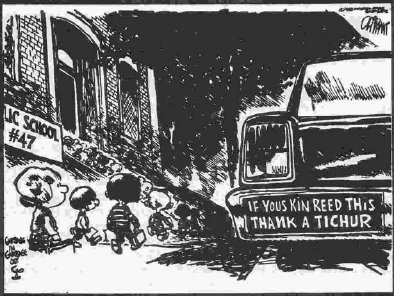
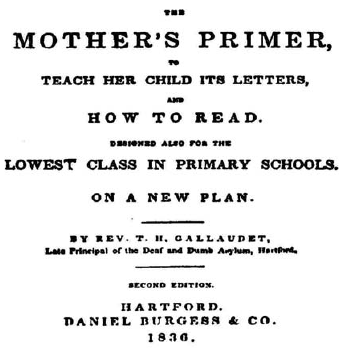
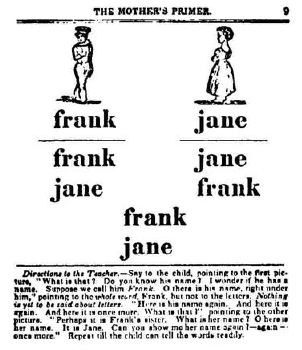 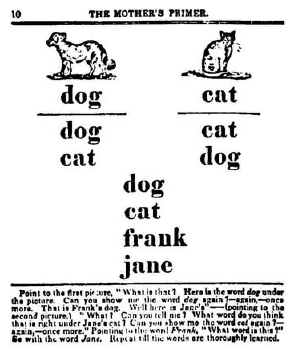
There
are two possible reasons. The reader can take his or her pick.
-
First, in 1853 Mann was appointed President of Antioch College. The
most influential Trustee of Antioch College was the co-founder of
The Order - Alphonso Taft.
-
Second, Mann never had a proper education and consequently was
unable to judge a good method from a bad method for reading.
Here's
a description of Mann's school days:
"The opportunities for the lad's schooling were extremely meager.
The locality enjoyed the reputation of being the smallest school
district, with the poorest school house and the cheapest teacher in
the State."
Mann's teacher was Samuel Barratt and we quote:
"In arithmetic he
was an idiot. He could not recite the multiplication table and could
not tell the time of day by the clock ... Six months of the year he
was an earnest and reliable teacher, tasting nothing stronger than
tea, then for another six months he gave himself up to a state of
beastly drunkenness ..."
By 1840 there was a backlash, and the look-say system was dropped in
Massachusetts.
The Second Attempt
Towards the end of the 19th century The Order came on the scene -
and the look-say method was revived. The youngest son of Thomas
Hopkins and Sophia Gallaudet was Edward Miner Gallaudet. Two of -is
sons went to Yale and became members of The Order:
-
Edson Fessenden Gallaudet ('93), who became an instructor of physics
at Yale
-
Herbert Draper Gallaudet ('98), who attended Union Theological
Seminary and became a clergyman
Then the method was adopted by
Columbia Teachers' College and :he Lincoln School. The thrust of the
new Dewey-inspired system of education was away from learning and
towards preparing a child to be a unit in the organic society.
Look-say was ideal for Deweyites. It skipped one step in the
learning process. It looked "easy," and de-emphasized reading
skills. The educational establishment rationalized look-say be
claiming that up to the turn of the century reading was taught by
"synthetic" methods, i.e., children were taught letters and an
associated sound value.
Then they learned to join syllables to make
words. This was held to be uninteresting and artificial. Educational
research, it was claimed, demonstrated that in reading words are not
analyzed into component letter parts but seen as complete units.
Therefore, learning to read should start with complete units.
Education
Of course, there is a gigantic non-sequitur in this reasoning
process. Certainly a skilled reader does see words as complete
units. And a really skilled reader does see lines and paragraphs at
a glance. But the accuracy of perceiving the whole is based on the
degree of understanding and knowledge of the component parts.
The educational establishment argues today in the 1980s that, based
on further experimental testing, it is easier for a child to read
the line "the rocket zoomed into space" than "the cat sat on the
mat." The first line has "contrasting visual structure" and the
second quote has a "similar visual pattern."
What they have done now is to make a mountain out of a molehill,
convert the relatively simple task of learning to read into an
unnecessarily complex system.
Why?
That we shall see as the story
progresses.
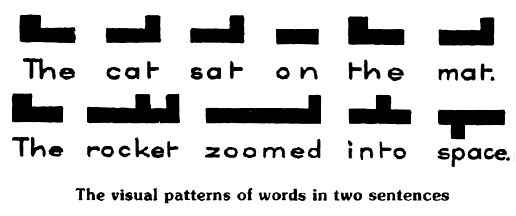
How children are taught to read - and why they can't.
Return to Contents
Memorandum Number Three:
The Illuminati Connection
We need to trace three historical lines in modern education: the
first we looked at in Memorandum Number Two, the development of the
look-say method of reading, its abandonment and its later adoption
around the turn of the century.
Another line is the import of the experimental psychology of Wilhelm Wundt into the United States by
The Order. This we shall examine in
Memorandum Number Four.
For the moment we want to briefly trace the influence of Johann
Friedrich Herbart, a major German philosopher of the early 19th
century. There was at one time in the United States a National
Herbart Society for the Scientific Study of Education to adapt
Herbartian principles to American education. Later, this became just
National Society for the Study of Education. You don't hear too much
about Johann Herbart today, but his influence survives in the
so-called "enriched" school curricula and in current educational
methodology.
Our purpose in this memorandum is twofold: to show the Hegelian
aspects of Herbartian theory and to trace the Illuminati connection.
There is no direct connection to The Order. However, in a subsequent
book, we will trace The Order to the Illuminati and this section
will then fall into a logical place.
Herbart was an educational theorist as well as philosopher and
psychologist, and strongly influenced Wilhelm Wundt. For Herbart,
education had to be presented in a scientifically correct manner,
and the chief purpose of education for Herbart is to prepare the
child to live properly in the social order of which he is an
integral part. Following Hegel, the individual is not important. The
mere development of individual talent, of individual fitness, mental
power and knowledge is not .he purpose of education. The purpose is
to develop personal character and social morality, and the most
important task of the educator is to analyze the activities and
duties of men within society.
The function of instruction is to fulfill these aims and impart to
the individual socially desirable ideas. Morality for Herbart,
therefore, is what is good for society, following Hegelian theory.
Herbartians favor grouping of subjects around a core topic, i.e.,
the grouping of history, social-science and English literature. This
enables the teacher to more easily draw out those notions useful to
the objective.
All of these ideas we can recognize in today's educational
philosophy came into American education through the Herbartian
groups.
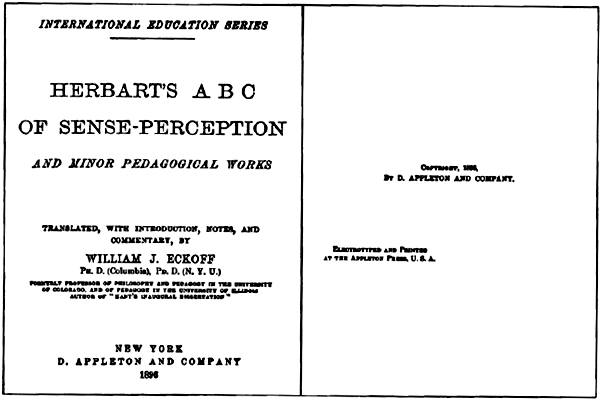
The Illuminati Connection
Johann Herbart studied at the University of Jena, and came under the
influence of Johann Herder, Friedrich Schiller, Johann Fichte and
Johann Goethe. Later, in Switzerland, Herbart came into contact with
Johann Pestalozzi.
What is interesting about these names, and they comprise the most
important influence on Herbart, is that they are either known
members of the Illuminati or reputed to be close to
the Illuminati
Order.
Let's take each name in turn:
-
Johann Gottried Herder (1744-1803) was "Damascus pontifex" in the
Illuminati.
-
Johann Fichte, we have already noted in the previous volume, was
close to the Illuminati and pushed by Goethe ("Abaris") for the post
at the University of Jena, where Johann Herbart was studying.
-
Friedrich Schiller (1759-1805) was known in the circle but not
reliably recorded as an Illuminati member.
-
Johann Wolfgang Goethe (1749-1832) was "Abaris" in the Illuminati.
We have an even more precise connection for another prominent
Illuminati, Johann Heinrich Pestalozzi (1746-1827), a Swiss teacher
of some renown living at Interlaken, and known as "Alfred" in the
Illuminati code.
Before Herbart completed his doctorate, just after the turn of the
19th century, he spent three years at Interlaken in Switzerland. Out
of his contact with Pestalozzi came a book on Pestalozzi's
educational theories, much of which rubbed off onto Herbart. The
book is PestaIozzi's Idee Eines ABC Der Anschaung Untersucht Und
Wissenschaftlich Asugefuhrt (Pestalozzi's idea of an ABC of sense
impression).
This book has been translated and we reproduce a copy
of .he title page of the 1896 New York edition. This is not
insignificant. It is a commentary by a prominent influence on
today's education upon an Illuminati book.
Why Is The Illuminati Connection Significant?
The Illuminati was founded May 1, 1776 by Professor
Adam Weishaupt
of the University of Ingolstadt. It was a secret society, but in
1785 and 1787 several batches of internal documents came to the
Bavarian Government. Subsequent investigation determined that the
aim of the Illuminati was world domination, using any methods to advance the objective, i.e., the end always justifies the means. It
was anti-Christian, although clergymen were found in the organization. Each
member had a pseudonym to disguise his identity.
During its time, the Illuminati had widespread and influential
membership. After suppression by the Bavarian Government in 1788 it
was quiet for some years and then reportedly revived.
The significance for this study is that the methods and objectives
parallel those of The Order. In fact, infiltration of the Illuminati
into New England is known and will be the topic of a forthcoming
volume.
So far as education is concerned, the Illuminati objective was as
follows:
"We must win the common people in every corner. This will be
obtained chiefly by means of the schools, and by open, hearty
behavior, show, condescension, popularity and toleration of their
prejudices which we shall at leisure root out and dispel."
As Rosenbaum
has pointed out in his Esquire article, the Illuminati
ceremony has similarities to The Order.
For example, John Robison in
Proofs Of A Conspiracy:
"The candidate is presented for reception
in the character of a slave; and it is demanded of him what has
brought him to this most miserable of all conditions. He answers -
Society - the State - Submissiveness - False Religion. A skeleton is
pointed out to him, at the feet of which are laid a Crown and a
Sword. He is asked whether that is the skeleton of a King, a
Nobleman or a Beggar?
As he cannot decide, the President of the meeting says to him, "the
character of being a man is the only one that is of importance."
Finally, in conclusion, we can trace the foundation of
three secret
societies, in fact the most influential three secret societies that
we know about, to Universities.
-
The Illuminati was founded at
University of Ingolstadt
-
The Group was founded at All Souls
College, Oxford University in England
-
The Order was founded at
Yale University in the United States"
The paradox is that institutions supposedly devoted to the search
for truth and freedom have given birth to institutions devoted to
world enslavement.
Return to Contents
Memorandum Number Four:
The Leipzig Connection*
*
The Leipzig Connection is the title of an excellent little booklet
by Lance J. Klass and Paoli Lionni. The book
came out in 1967 and was the first to trace the Wundt link. It has
more detail on Wundt than this memorandum, but, of course, is not
concerned with The Order.
The link between German experimental psychology and the American
educational system is through American psychologist G. Stanley Hall,
in his time probably the foremost educational critic in the U. S.
The Hall family is Scotch and English and goes back to the 1630s,
but Hall was not a Yale graduate, and at first sight there is no
connection between Hall and The Order.
On the other hand, Hall is a good example of someone whose life has
major turning points and on probing the turning points, we find The
Order with its guiding hand. The detail below is important to link
Hall with The Order. It is an open question how much Hall knew, if
he knew anything at all, about The Order and its objectives.
After graduation from Williams College, Hall spent a year at the
Union Theological Seminary, New York. Our "Addresses" books for
The
Order do not give church affiliations for members citing the
ministry as their occupation. We do know that Rev. Henry Sloane
Coffin ('97) was Associate Professor of Practical Theology at Union
from 1904-1926 and President of Union Seminary from 1926 to 1945,
but we cannot trace any members at Union before 1904.
Fortunately, Hall was an egocentric and wrote two long, tedious
autobiographies: Recreations Of A Psychologist and Life And
Confessions Of A Psychologist. This is how Hall described his entry
to Union in the latter book (pp. 177-8):
"Recovering from a severe attack of typhoid fever the summer after
graduation and still being very uncertain as to what I would be and
do in the world, I entered Union Theological Seminary in September
1867."
Later Hall adds,
"The man to whom t owe far more in this group than any other was
Henry B. Smith, a foreign trained scholar, versed more or less not
only in systematic theology, which was his chair, but in ancient and
modern philosophy, on which he gave us a few lectures outside the
course. Of him alone I saw something socially. He did me perhaps the
greatest intellectual service one man can render another by
suggesting just the right reading at the right time. It was he, too,
who seeing my bent advised me to go to Europe."
The Rev. Henry Boynton Smith cited by Hall was Professor of Church
History at Union Seminary from 1850 to 1874, and in the "liberal"
wing of the Presbyterian Church, he edited Theological Review from
1859-1874 and translated several German theological works. Smith was
not a member of The Order.
How did Hall, who says he was broke, get from New York to Europe,
specifically to Germany?
Here's the interesting twist. Someone he didn't know (but whom today
we can trace to The Order) gave him $1,000 - a lot of money in those
days. Here's how it happened. While preaching in Pennsylvania in
1868, Hall received a letter from Rev. Henry Ward Beecher, whose
church he attended in New York:
"... asking me to call on him. I immediately took the train and
Beecher told me that through the Manns (friends) he had learned that
I wished to study philosophy in Germany but lacked the means ...
(he) gave me a sealed note to the lumber magnate Henry Sage, the
benefactor of Cornell, which I presented at his office without
knowing its contents. To my amazement, after some scowling and a
remark to the effect that his pastor took amazing liberties with his
purse, he gave me a check for one thousand dollars. Taking my note
to repay it with interest, he told me to sail for Germany the next
day"
(Confessions, p. 182).
Who was "lumber magnate Henry Sage, the benefactor of Cornell"? The
Sage family had several "Henrys" involved with Yale and Cornell
Universities in those days. The "Henry Sage" cited is probably
William Henry Sage (1844-1924) who graduated Yale 1865 and then
joined the family lumber company, H.W. Sage & Company in New York.
Henry Sage was a member of Scroll & Key - the sister Senior Society
to Skull & Bones at Yale.
Furthermore, two of Henry Sage's nephews
were in The Order, but well after 1868:
-
Dean Sage ('97)
-
Henry Manning Sage ('90)
Both Sages entered the family lumber business, by then renamed
Sage,
Land & Lumber.
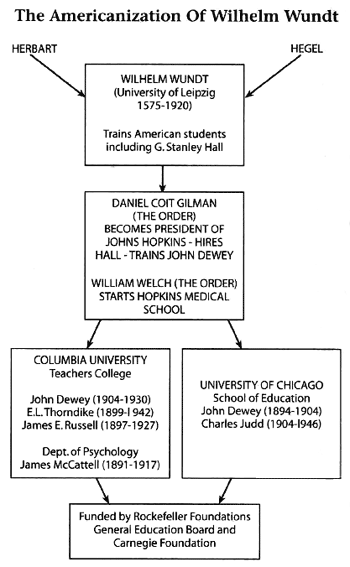
In brief: the funds to get Hall to Germany on his first trip came
from a member of Scroll & Key, i.e., Henry Sage, while Sage's two
nephews joined The Order later in the century. In Germany, Hall
studied philosophy at the University of Berlin for two years under
Hegelians Trendelenberg (Gilman of The Order also studied under
Trendelenberg) and Lepsius.
There were few American students in
Berlin at this time. So few that the American Minister George
Bancroft could entertain them at the U.S. Embassy to meet German
Chancellor von Bismarck.
Hall At Antioch College
Hall returned to the U.S. from Germany in 1871 and by design or
accident found himself under the wing of The Order.
Again, the detail is important. There are two versions of Hall's
life immediately after returning from his first trip to Germany.
According to Hall's Confessions, he became tutor for the Seligman
banking family in New York and was then contacted by James K.
Hosmer, Professor at Antioch College, Yellow Springs, Ohio. Hosmer
asked, and this is very unusual, if Hall would like his professorial
post at Antioch. Said Hall, "I gladly accepted."
There is another version in National Encyclopedia Of American
Biography which states,
"In 1872 he (Hall) accepted a professorship
at Antioch College, Ohio, that formerly was held by Horace Mann."
In any event Hall went to Antioch, a "liberal" Unitarian college
with a more than "liberal" view of education. And at Antioch
College, G. Stanley Hall was at the core of The Order.
Horace Mann, whom we met in Memorandum Two as the promoter of
"look-say" reading, was the first President of Antioch (1853-1860).
The most prominent trustee of Antioch College was none other than
the co-founder of The Order, Alphonso Taft. According to Hall, "(I)
occasionally spent a Sunday with the Tafts.
Ex-President Taft was
then a boy and his father, Judge Alonzo (sic) Taft was a trustee of
Antioch College" Confessions, p. 201). Furthermore, Cincinnati,
Ohio, at that time was the center for a Young Hegelian movement
including
famous left Hegelian August Willich, and these were well known to
Judge Alphonso Taft.
In brief, while at Antioch College in Yellow Springs, Ohio, Hall
came under the influence of four groups:
(a) the legend of Horace Mann, a
hero of the modern education movement
(b) the Unitarian
Church, which will enter our later reports
(c) a Hegelian discussion group comprised of left Hegelians
(d)
the co-founder of The Order, Alphonso Taft
And Hall knew William
Howard Taft, also a member of The Order ('78) and future President
and Chief Justice of the United States.
Hall stayed four years at Antioch, then took off again for Europe,
while Alphonso Taft went to Washington, D.C. as Secretary of War,
then as Attorney General in the Grant Administration. Hall paused a
while in England and then went on to Germany, to Leipzig and Wilhelm
Wundt. He became the first of a dozen Americans to receive a Ph.D.
in psychology (a new field) under Wundt.
The Hegelian Influence On Hall
So between 1870 and 1882, a span of twelve years, Hall spent six
years in Germany. As Hall himself comments,
"I do not know of any other American student of these subjects
(i.e., philosophy and
psychology) who came into even the slight personal contact it was my
fortune to enjoy with
Hartmann and Fechner, nor of any psychologist who had the experience
of attempting
experimental work with Helmholtz and I think I was the first
American pupil of Wundt. The
twelve years included in this span, more than any other equal
period, marked and gave direction to modern psychology ..."1
1 G. Stanley Hall. FOUNDERS OF MODERN PSYCHOLOGY. Appleton & Co.,
London, 1912, pp. v-vi.
Who were these four German philosophers who so influenced Stanley
Hall?
Eduard von Hartmann (1842-1906)
A prominent philosopher. Hartmann's
views on individual rights are entirely contrary to our own, i.e.,
"The principle of freedom is negative ... in every department of
life, save religion alone, compulsion is necessary ... What all men
need is rational tyranny, if it only holds them to a steady
development, according to the laws of their own nature."
There isn't too much difference between Hegel and Hartmann on the
idea of social progress. Individual freedom is not acceptable to
these philosophers, man must be guided by "rational tyranny."
Gustav Theodor Fechner (1801-1887)
Fechner disliked Hegel, who
Fechner said, "unlearned men to think." However, Fechner was mainly
interested in psycho-physics, i.e., parapsychology:
"... he was particularly attracted to the unexplored regions of
the soul and so he became interested in somnambulism, attended
seances when table tapping came into vogue."
Herman L. F. von Helmholtz (1821-1894)
Was undoubtedly Germany's greatest scientist
in the19th century and was rooted in Kant, the predecessor of Hegel.
For Helmholtz:
"The sensible world is a product of the interaction between the
human organism and an unknown reality. The world of experience is
determined by this interaction but the organism itself is only an
object of experience and is to be understood by psychology and
physiology."
Wilhelm Maximilian Wundt
Wilhelm Wundt (1832-1920), Professor of Philosophy at University of
Leipzig, was undoubtedly the major influence on G. Stanley Hall.
Modern education practice stems from Hegelian social theory combined
with the experimental psychology of Wilhelm Wundt. Whereas Karl Marx
and von Bismarck applied Hegelian theory to the political field, it
was Wilhelm Wundt, influenced by Johann Herbart, who applied Hegel
to education, which in turn, was picked up by Hall and John Dewey
and modern educational theorists in the United States.
Wilhelm Maximilian Wundt was born August 16, 1832 at Neckarau, a
suburb of Mannheim, Germany. His father Maximilian (1787-1846) was a
minister. Wundt's grandfather on the paternal side is of significant
interest: Kirchenrat Karl Kasimir Wundt (1744-84) was Professor at
Heidelberg University in the history and geography of Baden and
pastor of the church at Wieblingen, a small neighborhood town.
The Illuminati-Order documents show that "Raphael" in the IIluminati
is identified as this same Professor Karl Kasimir Wundt and is
referred to in the Illuminati Provincial Report from Utica (i.e.,
Heidelberg) dated September 1782.1
The magnum opus of Wilhelm Wundt, i.e., Volkerpsychologie, is also
today a recommended book in Internationales Freimaurer Lexikon (page
50).
Historical links aside, Wundt is important in the history of
American education for the following reasons:
(1) He established in 1875 the world's first laboratory in
experimental psychology to measure individual responses to stimuli.
'Richard van Dulman, Der Geheimbund Der Illuminaten (Stuttgart,
1977, p. 269).
(2)
Wundt believed that man is only the summation of his experience,
i.e., the stimuli that bear upon him. It follows from this that, for
Wundt, man has no self will, no self determination. Man is in effect
only the captive of his experiences, a pawn needing guidance.
(3)
Students from Europe and the United States came to Leipzig to learn
from Wundt the new science of experimental psychology. These
students returned to their homelands to found schools of education
or departments of psychology, and trained hundreds of Ph.D.s in the
new field of psychology.
The core of our problem is that Wundt's work was based on Hegelian
philosophical theory and reflected the Hegelian view of the
individual as a valueless cog in the State, a view expanded by Wundt
to include man as nothing more than an animal influenced solely by
daily experiences.
This Wundtian view of the world was brought back from Leipzig to the
United States by G. Stanley Hall and other Americans and went
through what is known among psychologists as "The Americanization of Wundt."
Although Hall was primarily psychologist and teacher, his political
views were partially Marxist, as Hall himself writes:
"... (I) had
wrestled with Karl Marx and half accepted what I understood of him"
(Confessions, p. 222).
In the next Memorandum, Number Five, we will
link Hall with Gilman and trace their joint influence on American
education.
Return to Contents
or
Continue
→
Return to The Controlled Global Education
|




